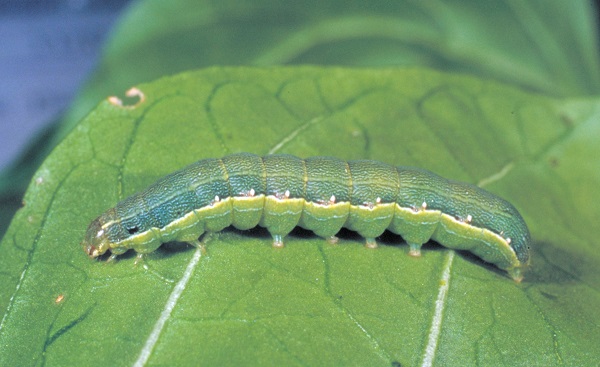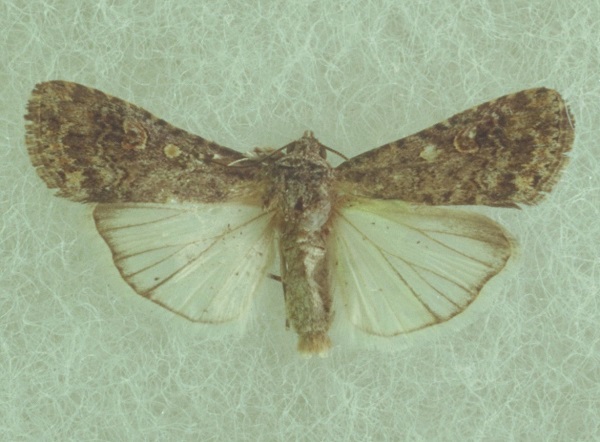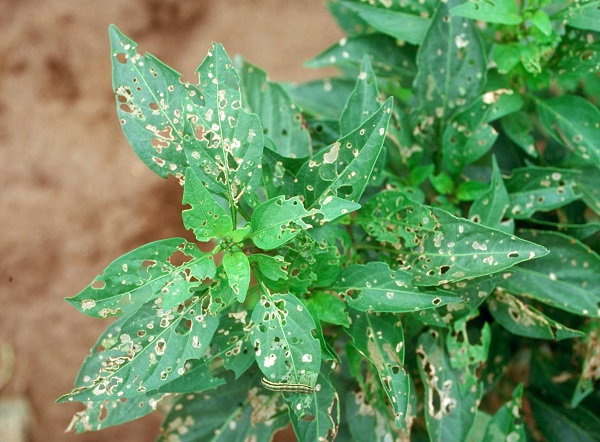Beet Armyworm in Kentucky
ENTFACT-308: Beet Armyworm in Kentucky | Download PDF
Ric Bessin, Extension Specialist
University of Kentucky College of Agriculture
The beet armyworm is a major pest in the southwestern and southern US attacking alfalfa, beans, beets, cole crops, corn, cotton, lettuce, onion, peppers, potatoes, peas, and tomatoes. It is an occasional invader of vegetable crops in Kentucky. Although it cannot overwinter here, it is a significant pest for vegetable growers because of its wide host range and resistance to most insecticides. This insect is killed by the first hard frosts in the fall. Producers of fall vegetable crops need to watch out for this pest during August and September.

Figure 1. Beet armyworm has a distinctive black spot above the 2nd pair of true legs.
The beet armyworm is a light-green to black larva with four pairs of abdominal prolegs and a dark head. There are many fine, white wavy lines along the back and a broader stripe along each side. There is usually a distinctive dark spot on each side just above the second pair of true legs.

Figure 2. Beet armyworm moth.
Female moths lay masses of up to 80 eggs underneath a covering of cottony-white scales, as many as 600 eggs over a 3 to 7-day period. These eggs hatch in 2 to 3 days and the larvae first feed together in a group near the egg cluster. As they grow, they gradually move away from the egg masses. Many small larvae die during this wandering stage but the behavior tends to spread out the infestation. Beet armyworm is quite mobile, one larvae may attack several plants in a row. Older larvae may feed on fruit as well as leaves. After they complete their feeding, the 1-1/4" inch larvae pupate in the soil in a loose cocoon containing soil particles and leaf fragments. The life cycle takes about a month to complete in warm weather.

Figure 3. Beet armyworm damage to pepper plants.
Beet armyworm feeding on young tender growth can be very damaging to small transplants. Often a fine webbing is produced by smaller larvae near these feeding sites. Older plants can become rapidly defoliated.
Vegetable growers should pay particular attention to fall plantings of beans, tomatoes, crucifers, other truck crops.
Management
Management guidelines in other states vary. In general, a treatment is recommended in cole crops when 3 to 10% of the plants are infested. In fresh market tomatoes, treatment is needed when 3% fruit feeding (shallow, dry-cavities in the fruit) is noted. In snap beans, sprays for beet armyworm are recommended when 20-30% defoliation occurs before bloom or 10-15% after bloom.
Beet armyworm has few effective parasites or predators which can effectively reduce its numbers. Most Bacillus thuringiensis formulations, which are used to control corn earworm, cabbage looper, imported cabbageworm, diamondback moth, and many other caterpillars are not effective against beet armyworm. Xentari, a Bt var azaiwi strain, is effective. If a complex of caterpillars including beet armyworm are present, Be sure to use a product effective against beet armyworm.
Recommended Insecticides
Timing of insecticide applications is very important. Once larvae are 1/2 inch or longer, they become very difficult to kill with many insecticides. So treatment must be targeted against young larvae. Only with frequent field surveys can these pests be detected and controlled effectively. Coverage is also an important consideration. Because insecticides can provide only moderate levels of control, it is important to deliver the proper dose to the pest. Drop nozzles, high pressure (200 psi), hollow cone nozzles, reducing sprayer speed (2 to 2.5 mpg), and a high volume spray will allow for thorough coverage of these vegetable crops.
Revised: 11/19
CAUTION! Pesticide recommendations in this publication are registered for use in Kentucky, USA ONLY! The use of some products may not be legal in your state or country. Please check with your local county agent or regulatory official before using any pesticide mentioned in this publication.
Of course, ALWAYS READ AND FOLLOW LABEL DIRECTIONS FOR SAFE USE OF ANY PESTICIDE!
Photos courtesy Ric Bessin, University of Kentucky Entomology
